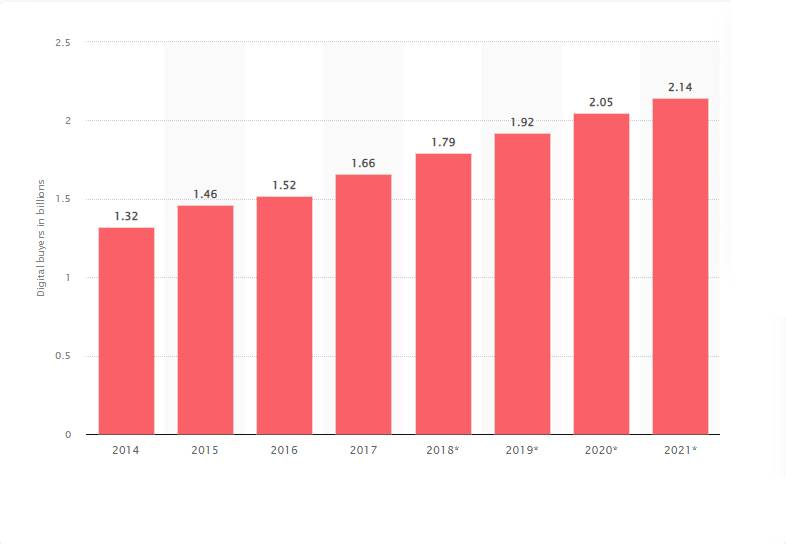What is eCommerce? – The Beginner’s Guide (2022)

There are hardly any people who aren’t unaware of what is eCommerce. It’s 2022 and every year this eCommerce industry keeps changing.
This ever-changing eCommerce industry and day by day new eCommerce stores keep coming.
And still, the number of purchasers isn’t stopping even though there are thousands of eCommerce stores out there.
These days, people are just a matter of minutes away from purchasing their favorite products right from their desktop or app.
This becomes too convenient, if you don’t find a product on one site then there are many others too.
As the delivery process becomes more convenient, one can easily purchase any product from overseas.
A detailed study of eCommerce site visits yielded a purchase ratio of around 2.86%.
There are many aspects of eCommerce that a new tech-savvy individual can learn a lot about.
In this comprehensive guide to what is eCommerce, we will cover a wide range of topics that beginners should know.
In this comprehensive guide to what is eCommerce, we are going to cover a wide range of topics that beginners should be aware of.
What is Ecommerce? How It All Started?
If you’re reading this then it’s completely ok if you don’t know what eCommerce is.
Because many people think that the sole meaning of eCommerce is purchasing physical products online.
But eCommerce is much more than that (which we’ll cover in short). Ecommerce also sells non-physical goods like digital goods and services.
Simply put, eCommerce stands for electronic commerce (trading products or services online).
Nowadays, a high number of businesses are coming online after COVID-19.
Talking about the latest stats, more than 2.14 billion people have made online purchases of goods and services in 2021. And as you can see in the graph below, these figures are continuing to rise.

One of the best examples of eCommerce stores is Amazon.
So, how exactly did it all start?
Around four decades AGO, the eCommerce world was created WITH the introduction of early technology like Electronic Data Interchange (EDI) and teleshopping.
However, online shopping was started as the internet became public in 1991.
So, what was the very first eCommerce website?
It’s none other than Amazon.
Amazon was the first eCommerce site in the United States, founded by Jeff Bezoz, to begin selling products online, and thousands of other businesses have since gotten on board.
And, from that day to this, the shopping experience has changed dramatically, and it is now difficult to imagine life without this convenience.
How Many Types of eCommerce Are There?
Many of us are only aware of the two business models B2B (business to business) and B2C (business to consumer) eCommerce.
But there are many other models that you must be aware of.
Ecommerce models vary greatly and involve a wide range of sales types. The following are the various sorts of eCommerce enterprises.
There are four major types of eCommerce business models.
Let’s checkout the difference.
B2B (Business to Business):
To simply understand the B2B model means, business selling goods and services to other businesses.
One great example of it is Alibaba. What Alibaba does is sell their products to other businesses.
Another great feature of Alibaba is that its prices are far too low, allowing many businesses to increase their profits.
Plus, this type of eCommerce model is more complicated than other forms of eCommerce because it relies on large catalogs of complex products to sell.
B2C (Business to Consumer):
This one, easy to understand and the majority of people know about it, is the B2C (business to consumer) model, which involves businesses selling to consumers.
And the great examples of B2C businesses are Amazon, Walmart, and ebay.
It’s very simple to understand, when you purchase a product for your own use. Some eCommerce stores also offer individualized products such as custom pet portraits to engage more customers.
Although B2C e-commerce appears to be more prevalent, it is only roughly half the size of the global B2B e-commerce sector.
C2C (Consumer to Consumer):
This is the third business model that many people are unaware of.
C2C means consumer to consumer, when consumer sells to other consumers, as simple as that.
A perfect list of C2C websites are eBay, Etsy, Airbnb, and more.
These types of sites aren’t businesses but one can sell or buy new or second-hand the products they want for their personal use.
C2B (Consumer to Business):
Some people may be unfamiliar with this term. It is the last major type of eCommerce business model – C2B (Consumer to Business).
When a customer adds value to a business, this is referred to as C2B.
- For example, when a customer helps a business to increase their sales and brand identity.
- When an influencer or a person promotes a product or software to their audience for the benefit of a company.
Thus, these are examples of C2B companies.
What exactly is an eCommerce website? How Many Different Types of eCommerce Sites Exist?
Now that you’ve learned about the four major types of eCommerce business models, you should also be aware of the various types of eCommerce sites.
Ecommerce website is the place where you can purchase or sell anything you want.
However, eCommerce is not always limited to physical products, eCommerce sites can also be service-based or digital-based.
Ecommerce sites where the purchases are made between sellers and customers.
Let’s look at the various types of eCommerce sites, starting with the most common.
1. Ecommerce Site Sells – Physical Products (Most Common):
We all know about this type.
Opening an offline store is far better than opening an online store to reach a broader audience.
It also saves you a lot of buck when compared to opening a physical store.
This type of store includes products like fashion items, furniture, electronics, tools, jewelry, and more.
Sites like Amazon, which provide same-day delivery and have simple checkout procedures, generate massive sales.
2. Ecommerce Site Sells – Services:
This is another most common method of eCommerce.
Services that can be taken online are a part of service-based eCommerce websites.
For example, freelancers giving services online. Moreover, consider handy, which provides a variety of services related to your home.
Now in service dearment there are two one can purchase a service.
Some service websites will prompt you to purchase their services right away at that moment, like buying online tools.
While some will take your through to fill your needs and will give you the service according to it.
3. Ecommerce Site Sells – Digital Products:
Now digital products means all the products that you can purchase and enjoy digitally.
Digital products include items such as coaching packages, e-books, games, software programs, and all.
The vast majority of the products are downloadable and do not require a physical store.
4. Ecommerce Site Sells – Dropshipping:
The concept is quite similar to selling physical products, but there’s a catch.
In dropshipping, a merchant sells goods to customers through their online store but does not keep any inventory.
Instead what merchants do is they find a supplier to sell goods from, wait for customers to buy these products, and the supplier fulfills the order for them.
So the orders will then be delivered directly to the customers by the supplier.
What Are The Best Ecommerce Platforms?
Now, if you want to develop your dream store, what is the finest platform to get started with?
You need to build your store on the right platform which will drive your store to success.
If you’re unfamiliar with the term “eCommerce platform,” it refers to a software solution that allows businesses to create online storefronts.
Here we’re recommending the three best eCommerce solutions that are worth considering.
1. WooCommerce:
The first choice would be none other than WooCommerce.
With WooCommerce, you can easily create your dream store with a plethora of plugins and themes to choose from.
There are currently 5,106,506 websites using WooCommerce, and 68,000 of the world’s top million websites.

WooCommrce is one of the largest and most popular platforms around the world.
The platform has all of the requisite skills, such as infinite customization, unlimited products, order management, and free shipping.
It doesn’t matter how big or small your business, WooCommerce easily caters to any level of business.
2. Shopify:
The second platform we highly recommend is Shopify.
If you have heard Shopify isn’t a decent platform to start an eCommerce store, then that’s absolutely wrong.
Shopify is a well-designed, powerful platform that allows anyone to launch an online store in minutes.
There are around 3,882,345 live stores of Shopify.

Shopify, a popular choice among many small and medium-sized businesses, enables clients to create online stores and easily scale their businesses.
Anyone without having a knowledge of coding can build their store without any problem.
There are dozens of stunning Shopify templates that are helpful to users creating the store they want.
Not only that, but it also has an easy-to-use interface, versatile shipping rates, and over 100 payment options.
3. Magento:
The third most reliable platform you can go with is Magento.
Magento currently powers around 630,747 live sites worldwide.

It’s the best platform you can take into consideration for your upcoming eCommerce store.
There are more than 6k+ extensions that can go with Magento.
Magento is a highly adaptable open-source E-commerce platform that is primarily utilized by medium-sized firms who are looking to scale.
Compared to all other eCommerce platforms out there, Magento really stands out in terms of offering robustness, beautiful design, and cutting-edge technology.
Magento, like the platforms discussed above, has incredible customization capabilities, appealing templates, and more.
What Are Popular eCommerce Stores?
Now you’re all aware of what ecommerce is, its types, and how it works.
You should also be aware of the most popular eCommerce stores on the market right now.
Let’s delve further to have a thorough understanding of the most prominent eCommerce platforms.
1. Amazon:
It’s everyone’s favorite platform.
Jeff Bezoz owns Amazon, which is currently the third most popular website in the entire United States.
It is so well-known that almost no one is unaware of it.
At this time, it’s very much hard to beat Amazon because the majority of the people trust Amazon for its service, affordability, and speed delivery.
Customers can shop from anywhere in the world, as it is available in most of the countries.
Amazon also lets others grow by creating a seller account in it.
2. Flipkart:
Flipkart is the second most popular eCommerce platform. It is India’s top level eCommerce company, ranking 11th.
It was founded by the two Indian entrepreneurs named Binny Bansal and Sachin Bansal.
the most renowned eCommerce website in India, and it is enabling a large number of Indian enterprises to enter the competitive online retail industry.
This multi-vendor website provides a platform for vendors to showcase their products to website users.
Flipkart is just like Amazon, you’ll get every product you want for yourself.
This multi-vendor website serves as the platform for vendors to display their product to the website’s visitors.
Wrapping Up
For most of us, it’s hard to imagine modern life without eCommerce. It would not only be inconvenient but also much more complicated.

![21 eCommerce Trends You Must Be Aware Of [Apr 2022]](https://templatemela.com/wp-content/uploads/Marketing-1-1.jpg)




I Would Explain it to You…